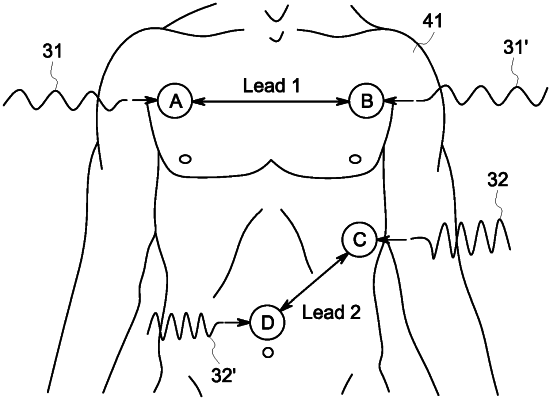| CPC A61B 5/0826 (2013.01) [A61B 5/0535 (2013.01); A61B 5/0809 (2013.01); A61B 5/6823 (2013.01); A61B 5/7278 (2013.01); A61B 5/7282 (2013.01); A61B 2562/0209 (2013.01)] | 9 Claims |

|
1. A method of impedance-based apnea metric monitoring for apnea detection using a first set of electrodes and a second set of electrodes comprising a three electrode arrangement configured to record impedance respiration data from a patient's chest and abdomen, wherein the first set of electrodes includes a first electrode and a second electrode, and the second set of electrodes includes the second electrode and a third electrode, the method comprising:
injecting a first carrier frequency at a first phase into the first electrode, and receiving the first carrier frequency at the first phase at the second electrode;
injecting the first carrier frequency at a second phase into the second electrode, and receiving the first carrier frequency at the second phase at the first electrode;
injecting a second carrier frequency at a first phase into the second electrode, and receiving the second carrier frequency at the first phase at the third electrode;
injecting the second carrier frequency at a second phase into the third electrode, and receiving the second carrier frequency at the second phase at the second electrode;
determining a first series of impedance measurements based on the first carrier frequency received at the first and second electrodes, wherein the first series of impedance measurements measures thoracic breath activity;
determining a second series of impedance measurements based on the second carrier frequency received at the first and second electrodes, wherein the second series of impedance measurements measures abdominal breath activity;
calculating a first apnea metric based on the first series of impedance measurements;
calculating a second apnea metric based on the second series of impedance measurements; and
detecting an apnea event only when both the first apnea metric indicates insufficient breath activity occurring at the patient's chest and the second apnea metric indicates insufficient breath activity occurring at the patient's abdomen.
|